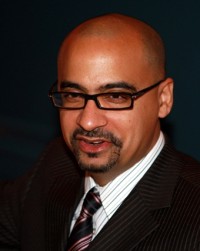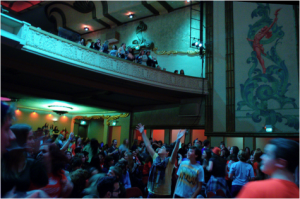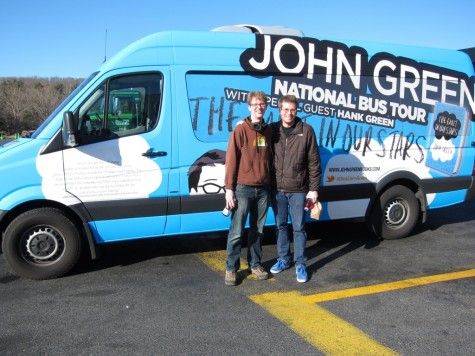Theme Essay by Martha Nichols
OMG! It's John, Hank, Joanne, and Junot!
Here’s a headline I don’t associate with literary authors: “Junot Díaz Nearly Causes a Riot at New York City Book Signing.”

But last September, when Díaz went on tour for his short story collection This Is How You Lose Her, he drew mobs in many cities. Of the riotous Manhattan book signing, at the Barnes and Noble in Union Square, one reporter notes that some “disappointed admirers” who couldn’t get a seat tried to sneak up an escalator, only to be halted by the NYPD.
From Díaz to J.K. Rowling, it’s clear that the relationship between fans and famous authors is shifting. The bestselling elite now attract Twitter hordes of paparazzi, and many fans want to connect personally with their favorite writers.
Should I be worried that adoring literary acolytes often care more about an author’s life than any of that writer’s novels or stories?
Okay, I’m worried. A little. But I still love it when authors make the news feeds. Mainstream media is obsessed with celebrities, and I’d rather a writer like Díaz, a National Book Award finalist and MacArthur “genius” fellow, grabs some of that action than, say, Justin Bieber.
At the National Book Awards ceremony last November, William Alexander, whose Goblin Secrets won in the “Young People’s Literature” category, got the red-carpet treatment along with Díaz, Elmore Leonard, and other literary stars. Reports Capital New York:
Stepping off the carpet, Alexander was mobbed by admirers. One woman announced that she’d just bought her 11-year-old son a copy of Goblin Secrets.
‘I love 11,’ Alexander said. ‘The books you read at 11 permanently alter the shape of your brain.’
‘I trust you!’ the woman said.
YA authors like Alexander, Rowling, and John Green have some of the most dedicated followings. These fans not only memorize every detail of an author’s fictional world but also want to know who that writer is. Younger authors like Green and Libba Bray are especially adept at using YouTube and social media to create the personas their fans love.
Case in point: Green’s book tour-cum-performance-event last spring, in which he was promoting his latest novel, The Fault in Our Stars, but also his geeky celebrity self. In her article “John Green’s ‘Tour de Nerdfighter,’” TW editor Karen Ohlson reported on attending a sold-out Northern California tour event with her teenage daughter.
Green is the award-winning author of YA titles such as Looking for Alaska. But he’s also the coproducer of a popular YouTube channel with his brother, Hank Green. The Greens, known as the Vlogbrothers, have a huge following of fellow “Nerdfighters”—close to 900,000 subscribers (“This many nerds can’t possibly be wrong!”) on YouTube alone. Their 2009 video “How to Be a Nerdfighter” has garnered well over a million views.

The popularity of these videos is surely one reason why the book tour Karen describes resembled a “rock concert, Nerdfighter-style.” The shrieks of 1,300-plus (mostly) teenage girls in a movie theater is a far cry from the average bookstore reading.
Now, I’m more likely to read an abandoned shopping list by John Green than to watch a video. So I wondered, in a comment I made on Karen’s piece, whether this author’s YouTube gimmick really matters more to readers than the actual quality of his writing. If so, uh-oh.
Karen reported that her own daughter insisted she and her friends were drawn to Green’s books first. But another TW reader—”Billy Tennery, Adult Nerdfighter”—responded to my comment, too, arguing that without the vlog, “I never would have picked up a John Green book, and thus would have missed out on his extraordinary writing.”
One of Billy’s most thought-provoking remarks speaks directly to the desire to know who authors are in order to engage with their work. An excerpt:
[P]art of the wonder of reading John’s books is that [they're in] his voice. I can see him and understand the writing…because of the relationship he has built with myself and his other readers…. When I read one of John’s books, I’m left wondering afterward what conversations and videos from Ray Bradbury, Orson Wells, Terry Brooks, Brent Weeks, and David Eddings would have looked like.
Oh, how I would love to hear the insights and the real life experiences of Emily Dickinson and George Orwell as well as political and social commentary of William Golding. All we have of these authors are the tools they left behind.
My kneejerk response is old school. As an editor, a recipent of a creative writing MA, and a denizen of many English lit classes pre-2000, “the tools they left behind” are enough for me. The best poems and essays reflect the inner lives of writers like Dickinson and Orwell more powerfully than their letters or other personal musings.
Yet, I can’t help wondering about Dickinson with a smart phone in her hand. Perhaps she’d point the lens at the birds outside her window, providing a quirky voiceover. Or dyspeptic Orwell would blog away, sending his screeds into the night like a latter-day Andrew Sullivan. The thought of hearing Dickinson’s voice—melodious? squeaky?—gives me chills.
Of course, I might not understand her or Orwell any better if they spoke to me from a video screen. They were both intensely private individuals. “George Orwell” was a pseudonym for Eric Blair and a means of setting boundaries with his reading public. Still, it is possible I’d relate to their printed words differently if I encountered the authors in the equivalent of a vlog. As Karen writes in her essay about John Green’s impact on fans:
What started as a jokey attempt to create ‘Brotherhood 2.0′ in a YouTube vlog has instead created something more like ‘Readership 2.0.’
I’d say we’re also well into Authorship 2.0. And it’s not bad—how could it be with fans like Billy? In his list of the ways the Vlogbrothers have changed him, he included “I am a better person for having found them” and “I have far more empathy, thanks solely to them.”
I doubt any author could ask for more engagement with his or her words.
For more about the Vlogbrothers, don't miss Karen Ohlson's John Green's "Tour de Nerdfighters" (Talking Writing, March/April 2012).
Publishing Information
- “Junot Díaz Nearly Causes a Riot at New York City Book Signing” by Aura Bogado, Colorlines, September 12, 2012.
- “At the National Book Awards, Good Feelings for an Embattled Industry” by Jed Lipinski, Capital New York, November 15, 2012.
- The Fault in Our Stars by John Green (Dutton, 2012).
- Looking for Alaska by John Green (Dutton, 2005).
- “How to Be a Nerdfighter: A Vlogbrothers FAQ” by the Vlogbrothers, YouTube, December 27, 2009.
Art Information
- Writer Junot Díaz at the Mercantile Library Center for Fiction's Annual Benefit and Awards Dinner, held at the New York Tennis and Racquet Club at 350 Park Avenue, where he won the John Sargent, Sr. First Novel Prize of $10,000, October 29, 2007 © Christopher Peterson; Creative Commons license
- Photo of John and Hank Green on tour © Elyse Marshall; courtesy of Penguin Group; used by permission
- Tour de Nerdfighting, Fox Theater, January 2012 © VaguelySerious; Creative Commons license
She likes the Vlogbrothers—her son loves “50 Jokes in Four Minutes,” a 2008 Hank clip that’s racked up 2-million-plus views—but she’ll take the concluding pages of John Green’s 2008 novel Paper Towns any day. For Martha, it’s about the writing. Always.
“Too often, I’ve suppressed my creative fire. For too long, I’ve ridden my anger like a beautiful tiger, running, running—on the attack, until I panic and swerve in the other direction, locking away all that glorious strength.” — “Wrath: The Tiger Inside”


